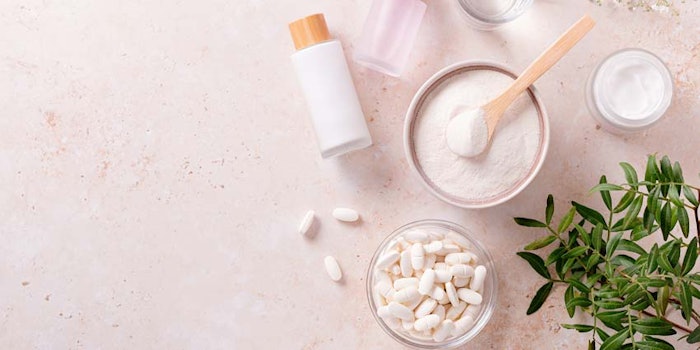
The nutricosmetics market was valued at approx. US $6.93 billion in 2020, according to Mordor Intelligence, and is estimated to register a healthy CAGR of 8.05% between 2021 and 2026.
There is robust demand for products that contain vitamins and omega-3, especially for skin care, which holds a significant share in the market. Moreover, the beauty-from-within approach is garnering popularity among millennials, as it is an attractive combination of beauty and health.
Then there are probiotics. Globally, the market for probiotic cosmetics was valued at US $252.5 million in 2019, which is expected to rise with a CAGR of 6.5% from 2020 to 2027, according to Grand View Research. Growing acceptance of probiotics as dietary supplements has increased their demand in the cosmetics segment.
Reported uses for these products range from acne, rosacea and eczema, to chronic inflammation, psoriasis and even anti-dandruff. Moreover, the Grand View Research reports consumers are willing to pay a premium price for ingredients that are proven to nourish skin due to growing consciousness about physical appearance and skin care routines.
Probiotics can be viewed as nutricosmetics; Kline has previously classified them this way, not to mention there are well-known connections between gut and skin health. One might even go so far as to extend nutritional benefits to the skin microbiome. It is at this intersection of nutritionals and pre-, pro- and postbiotics where recent anti-acne research and this brief commentary from Shaheen Majeed, of Sabinsa, fits in.
See archived: "Gut" Instinct Could Defeat Atopic Dermatitis
Pre-, Pro- and Postbiotics
More and more cosmetics, from oral care to skin care, are targeting the microbiome and are marketed to contain probiotic as well as prebiotic or postbiotic ingredients. As a point of clarification, as previously defined, a probiotic is a viable microorganism, live or dormant, added to a product to achieve a cosmetic benefit at the application site, either directly or via an effect on existing microbiota.
'I think the real breakthrough ... would be to use a probiotic for nourishment from the inside, while the postbiotic does the skin work.'
On the other hand, a prebiotic is a non-viable ingredient added to a product as a nutrient, intended for use by the microbiota on the application site. A postbiotic is a non-viable ingredient composed of inactivated microorganisms and/or soluble factors, e.g., products or metabolic by-products, also added to affect existing microbiota.
“The emerging field of postbiotics continues to garner interest from the scientific community ...” noted Shaheen Majeed, president worldwide of Sabinsa and a co-author of a related anti-acne study. To provide context for the study, the company's commercial LactoSpore probiotic preparation containing the L(+) lactic acid-producing bacteria Bacillus coagulans MTCC 5856 achieved success in supplements, beverages, baked goods and more but Sabinsa wanted to explore possibilities on the cosmetic front.
Anti-acne Postbiotic
Sabinsa introduced LactoSporin (INCI: Bacillus Ferment Filtrate Extract), a metabolic byproduct, or postbiotic, of its existing probiotic to help improve the composition of skin’s beneficial bacteria. This topical ingredient was put to the test in a clinical to evaluate its effects in mild to moderate acne; the work was published in Cosmetics.
Briefly, a cream containing 2% w/w of the postbiotic proved to be a safe and effective anti-acne formulation, with efficacy comparable to standard treatment with 2.5% benzoyl peroxide gel. The onset of efficacy was as early as three days, especially for closed comedones.
The major finding, however, was the ingredient reduced sebum secretion via its 5-alpha reductase inhibitory and antimicrobial properties, which proved to be better than benzoyl peroxide. This suggested a potential for other seborrheic conditions.
"This study shows [the postbiotic] is highly suitable for treating subjects with mild to moderate Acne vulgaris,” Majeed noted.
See archived: Glycolic Acid vs. pH, Jackfruit and Antimicrobial Peptides; Anti-acne Literature
Combined Strategy for the Next Normal
Circling back to nutricosmetics, however, Majeed observed, "I think the real breakthrough, if a good brand marketing company can master it, would be to use a probiotic for nourishment from the inside, while a postbiotic does the skin work." He gave the example of combining Sabinsa's probiotic ingestible with its postbiotic topical.
This holistic approach would connect with consumer concerns for not just beauty, but health; along with shifting priorities during and post-pandemic. "I’ve been pushing for nutricosmetics in Europe for a few years now. [T]he response rate and conversations are increasing, and more are asking for these types of products."
During the pandemic, he noted "A few projects took off in skin care [and] some new lines were brought out. ... The trends we saw were more on the safety of the skin [and] keeping skin (or hair) clean ... but [this] was milder than the years before."
He continued, "I know that all of last year, many of our [supplement] customers really went back to the basics, they focused on their SKU’s that were selling well, and would only detour toward anything new on the immunity side; no real product development or new SKU’s [were created]. The supply chain worries were real and put a hamper on anything new for our supplement customers."
He added that demand for Sabinsa's Indian botanicals typically used in finished brands for anti-aging—or pro-aging, as he refers to it—to impart skin radiance and treat mildly damaged hair generally stayed more or less the same.
Looking forward, he shared, "We expect to see an increase as projects are [now] ramping up, more ideas are on the table, [there are] more questions on our ingredients [and they are] being sought after; those are all good signs."










